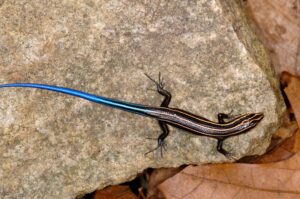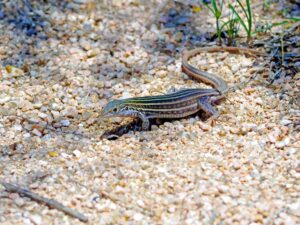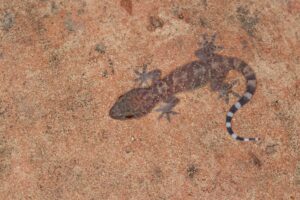Exploring the Different Types of Lizards Found in Kentucky
Lizards are often thought of as a low-maintenance pet when compared to other animals, but they can be quite fascinating creatures that play an important role in the environment.

Different Types of lizards in Kentucky
In Kentucky, lizards are common and come from several different species. Here is a look at some of the most commonly found lizards in the state:
Eastern Fence Lizard (Sceloporus undulatus)
Classification: Native Species
Description: The Eastern Fence Lizard typically measures 4 to 7.5 inches in length. It has a rough, scaly appearance with a gray to brown back, often displaying faint wavy lines. Males are distinguished by their bright blue bellies and throat patches, while females and juveniles usually have more subdued colouring.
Habitat: Found in open woodlands, rocky outcrops, and grassland edges. These lizards are often seen basking on logs, rocks, and sunny fences, preferring habitats with abundant cover and basking sites.
Behaviour: Known for their quick, darting movements and ability to climb vertical surfaces. They are primarily active during the day and are often seen basking in the sun. Males establish territories during the breeding season and may display their blue patches to attract females and deter rivals.
Range: Distributed throughout the eastern United States, including Kentucky, they are common in areas with suitable habitats.
Found in these States: Widespread across Kentucky and other eastern states.
Diet: Insectivorous, feeding primarily on ants, beetles, and spiders. Occasionally consumes small invertebrates and plant material.
Reproduction: Breeds in the spring, with females laying clutches of 3 to 16 eggs in sandy or loose soil. Eggs hatch in late summer after an incubation period of about 6 to 8 weeks.
Status: Listed as Least Concern due to their broad range and stable population.
Subspecies: None
Taxonomy:
- Kingdom: Animalia – Animals
- Phylum: Chordata – Chordates
- Subphylum: Vertebrata – Vertebrates
- Class: Reptilia – Reptiles
- Order: Squamata – Lizards
- Family: Phrynosomatidae – Spiny Lizards
- Genus: Sceloporus
- Species: Sceloporus undulatus – Eastern Fence Lizard
Five-Lined Skink (Plestiodon fasciatus)
Classification: Native Species
Description: The Five-Lined Skink is a medium-sized lizard, ranging from 5 to 8.5 inches in total length. It is easily identifiable by its glossy scales and the five yellow or white stripes running down its back. Juveniles and some females exhibit a bright blue tail.
Habitat: Prefers moist, wooded environments, often found under logs, leaf litter, or in rotting stumps. They thrive in environments with plenty of cover and hiding spots.
Behavior: These skinks are secretive and elusive, often hiding when threatened. They are diurnal, active during the day, and are proficient climbers.
Range: Common across the eastern United States, including Kentucky, particularly in forested areas.
Found in these States: Throughout Kentucky and other areas in the eastern U.S.
Diet: Their diet consists mainly of insects and other small invertebrates, such as crickets, beetles, and spiders.
Reproduction: Mating occurs in the spring, with females laying 4 to 14 eggs in early summer. The eggs are often hidden under logs or in decaying wood, and the female may guard the eggs until they hatch.
Status: Listed as Least Concern due to their adaptability and widespread presence.
Subspecies: None
Taxonomy:
- Kingdom: Animalia – Animals
- Phylum: Chordata – Chordates
- Subphylum: Vertebrata – Vertebrates
- Class: Reptilia – Reptiles
- Order: Squamata – Lizards
- Family: Scincidae – Skinks
- Genus: Plestiodon
- Species: Plestiodon fasciatus – Five-Lined Skink
Broadhead Skink (Plestiodon laticeps)
Classification: Native Species
Description: The Broadhead Skink is one of the largest skinks in Kentucky, reaching up to 13 inches in length. Adults have a robust body with a distinctive wide head. Males display a bright orange-red coloration on their heads during the breeding season, while females and juveniles are brown with lighter stripes.
Habitat: Found in wooded areas, especially in forests with heavy leaf litter and abundant fallen logs. They prefer habitats that provide ample cover and basking sites.
Behavior: Broadhead Skinks are arboreal, often seen climbing trees and shrubs. They are solitary and territorial, with males fiercely defending their territories during the breeding season.
Range: Distributed across the southeastern United States, including southern Kentucky.
Found in these States: Present in Kentucky, particularly in forested regions.
Diet: Primarily insectivores, their diet includes insects, spiders, and occasionally small vertebrates.
Reproduction: Breeding occurs in spring, with females laying clutches of 8 to 22 eggs in concealed nests. The female guards the eggs until they hatch after about 6 to 8 weeks.
Status: Considered Least Concern due to their adaptability and wide distribution.
Subspecies: None
Taxonomy:
- Kingdom: Animalia – Animals
- Phylum: Chordata – Chordates
- Subphylum: Vertebrata – Vertebrates
- Class: Reptilia – Reptiles
- Order: Squamata – Lizards
- Family: Scincidae – Skinks
- Genus: Plestiodon
- Species: Plestiodon laticeps – Broadhead Skink
Little Brown Skink (Scincella lateralis)
Classification: Native Species
Description: This small skink typically measures 3 to 5.5 inches in length. It has a slender body with smooth, shiny scales and a brown or coppery color with a dark stripe running along each side.
Habitat: Prefers moist leaf litter in forested areas, often found in woodland floors, gardens, and fields with abundant leaf cover.
Behavior: Little Brown Skinks are ground-dwelling and highly secretive. They are active foragers, often seen darting through the leaf litter in search of food.
Range: Common in the southeastern United States, including Kentucky.
Found in these States: Throughout Kentucky and other southeastern states.
Diet: Mainly insectivorous, feeding on small insects, spiders, and other invertebrates.
Reproduction: Mating occurs in spring, with females laying 1 to 7 eggs in moist, hidden locations. Eggs hatch in late summer after 4 to 6 weeks.
Status: Listed as Least Concern due to their stable populations and wide range.
Subspecies: None
Taxonomy:
- Kingdom: Animalia – Animals
- Phylum: Chordata – Chordates
- Subphylum: Vertebrata – Vertebrates
- Class: Reptilia – Reptiles
- Order: Squamata – Lizards
- Family: Scincidae – Skinks
- Genus: Scincella
- Species: Scincella lateralis – Little Brown Skink
Six-Lined Racerunner (Aspidoscelis sexlineata)
Classification: Native Species
Description: The Six-Lined Racerunner is a sleek, fast-moving lizard, reaching lengths of 6 to 10 inches. It is characterized by six distinct yellow or white stripes running down its green or brown back.
Habitat: Prefers open habitats like sandy areas, grasslands, and open woodlands. They are often found basking in sunny spots and require loose soil for burrowing.
Behaviour: Known for their speed, these lizards are active during warm days and are often seen darting across open areas. They are primarily terrestrial and diurnal.
Range: Found throughout the southeastern United States, including Kentucky.
Found in these States: Present in Kentucky and other southeastern regions.
Diet: Primarily insectivorous, their diet includes a variety of insects and other small invertebrates.
Reproduction: Breeding occurs in late spring, with females laying 2 to 6 eggs in sandy soil. Eggs hatch in mid to late summer.
Status: Considered Least Concern due to their extensive range and population stability.
Subspecies: None
Taxonomy:
- Kingdom: Animalia – Animals
- Phylum: Chordata – Chordates
- Subphylum: Vertebrata – Vertebrates
- Class: Reptilia – Reptiles
- Order: Squamata – Lizards
- Family: Teiidae – Whiptails
- Genus: Aspidoscelis
- Species: Aspidoscelis sexlineata – Six-Lined Racerunner
Ground Skink (Scincella lateralis)
Classification: Native Species
Description: The Ground Skink is a small, slender lizard with smooth, shiny scales. Its colouration ranges from coppery brown to a bronze hue, often with a darker stripe running down each side.
Habitat: Prefers loose soil and leaf litter in moist wooded areas, often found under logs or leaves where it can easily burrow.
Behavior: Terrestrial and secretive, this lizard is most active during the day, spending much of its time hidden under cover.
Range: Found throughout the southeastern United States, including Kentucky.
Found in these States: Present in Kentucky and other eastern and southeastern regions.
Diet: Primarily insectivorous, feeding on small insects, spiders, and other invertebrates.
Reproduction: Breeding occurs in spring and early summer, with females laying several clutches of 1 to 7 eggs throughout the season.
Status: Least Concern, as they have a wide distribution and stable population.
Subspecies: None
Taxonomy:
-
- Kingdom: Animalia – Animals
- Phylum: Chordata – Chordates
- Subphylum: Vertebrata – Vertebrates
- Class: Reptilia – Reptiles
- Order: Squamata – Lizards
- Family: Scincidae – Skinks
- Genus: Scincella
- Species: Scincella lateralis – Ground Skink
Coal Skink (Plestiodon anthracinus)
Classification: Native Species
Description: A small lizard characterized by smooth, shiny scales and a dark lateral stripe. Its body is typically brown or olive in color.
Habitat: Prefers moist wooded areas, often near streams or other bodies of water. They are frequently found under rocks, logs, and leaf litter.
Behavior: Primarily terrestrial and secretive, they are active during the day and often stay hidden under cover.
Range: Distributed throughout the eastern United States, including parts of Kentucky.
Found in these States: Present in Kentucky and neighboring eastern states.
Diet: Insectivorous, feeding on a variety of insects and other small invertebrates.
Reproduction: Breeding occurs in spring, with females laying 6 to 10 eggs, which they often guard until hatching.
Status: Considered Least Concern due to stable populations.
Subspecies: None
Taxonomy:

-
- Kingdom: Animalia – Animals
- Phylum: Chordata – Chordates
- Subphylum: Vertebrata – Vertebrates
- Class: Reptilia – Reptiles
- Order: Squamata – Lizards
- Family: Scincidae – Skinks
- Genus: Plestiodon
- Species: Plestiodon anthracinus – Coal Skink
Common Wall Lizard (Podarcis muralis)
Classification: Introduced Species
Description: A small, agile lizard with a slender body and long tail, featuring a variety of patterns and colors, often green or brown.
Habitat: Prefers rocky areas, walls, and ruins, often found in urban environments.
Behavior: Diurnal and highly active, they bask in the sun and are quick to flee when threatened.
Range: Originally from Europe, they are now found in localized areas in North America, including Kentucky.
Found in these States: Spotted in Kentucky and some other states where introduced.
Diet: Primarily feeds on insects and small arthropods.
Reproduction: Breeding occurs in spring, with females laying 2 to 10 eggs per clutch.
Status: Not evaluated, but locally common where established.
Subspecies: None
Taxonomy:
-
- Kingdom: Animalia – Animals
- Phylum: Chordata – Chordates
- Subphylum: Vertebrata – Vertebrates
- Class: Reptilia – Reptiles
- Order: Squamata – Lizards
- Family: Lacertidae – Wall Lizards
- Genus: Podarcis
- Species: Podarcis muralis – Common Wall Lizard
Mediterranean House Gecko (Hemidactylus turcicus)
Classification: Introduced Species
Description: Small, nocturnal lizard with a translucent appearance and sticky toe pads, allowing it to climb smooth surfaces.
Habitat: Often found in urban areas, including buildings and homes, where they can be seen near light sources at night.
Behavior: Nocturnal and insectivorous, they are often seen hunting insects attracted to lights.
Range: Native to the Mediterranean region, now widely established in warmer areas, including parts of Kentucky.
Found in these States: Present in Kentucky and various southern states.
Diet: Eats insects and other small invertebrates.
Reproduction: Females lay small clutches of eggs throughout the warmer months.
Status: Least Concern due to their adaptability and widespread distribution.
Subspecies: None
Taxonomy:
- Kingdom: Animalia – Animals
- Phylum: Chordata – Chordates
- Subphylum: Vertebrata – Vertebrates
- Class: Reptilia – Reptiles
- Order: Squamata – Lizards
- Family: Gekkonidae – Geckos
- Genus: Hemidactylus
- Species: Hemidactylus turcicus – Mediterranean House Gecko
Southeastern Five-lined Skink (Plestiodon inexpectatus)
Classification: Native Species
Description: The Southeastern Five-lined Skink closely resembles the Five-lined Skink but can be distinguished by its slightly less pronounced stripes. Juveniles lack the vibrant blue tail seen in other five-lined species. Adults have a sleek body with a glossy appearance, often displaying a mix of browns and cream-colored stripes.
Habitat: This skink favors drier, sandy habitats and is commonly found in open woodlands, forest edges, and areas with substantial ground cover. They thrive in environments with loose leaf litter or debris where they can easily hide.
Behavior: Diurnal and terrestrial, the Southeastern Five-lined Skink is known for its quick movements and elusive nature. It spends much of its time foraging on the ground, often basking in sunlit patches.
Range: Found predominantly throughout the southeastern United States, including Kentucky.
Found in these States: Present in Kentucky and extends throughout other southeastern regions.
Diet: Primarily insectivorous, the skink’s diet consists of a variety of insects, spiders, and other small invertebrates, which they actively hunt during the day.
Reproduction: Breeding occurs in the spring, with females laying eggs in concealed locations such as under logs or within loose soil. They lay clutches of 4 to 15 eggs, which they may guard until hatching.
Status: Considered Least Concern due to their wide distribution and stable population numbers across their range.
Subspecies: None
Taxonomy:
-
- Kingdom: Animalia – Animals
- Phylum: Chordata – Chordates
- Subphylum: Vertebrata – Vertebrates
- Class: Reptilia – Reptiles
- Order: Squamata – Lizards
- Family: Scincidae – Skinks
- Genus: Plestiodon
- Species: Plestiodon inexpectatus – Southeastern Five-lined Skink
Conclusion
In addition to their beauty and interesting behaviors, lizards play a key role in the ecosystems of Kentucky. They help to control insect populations, disperse seeds, pollinate flowers, and recycle vital nutrients back into the soil. For these reasons alone they should be appreciated and protected from harm as much as possible. With proper care and management, these amazing lizards can be an enjoyable addition to any home. So take the time to learn about and appreciate the wonderful variety of lizards found in Kentucky!
